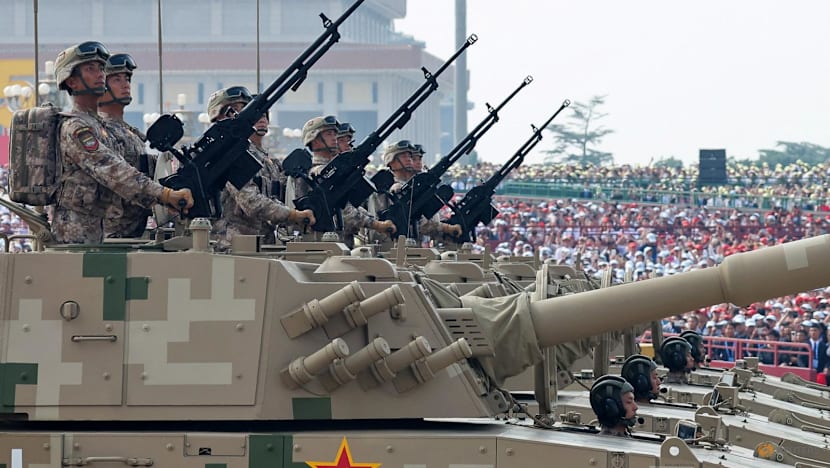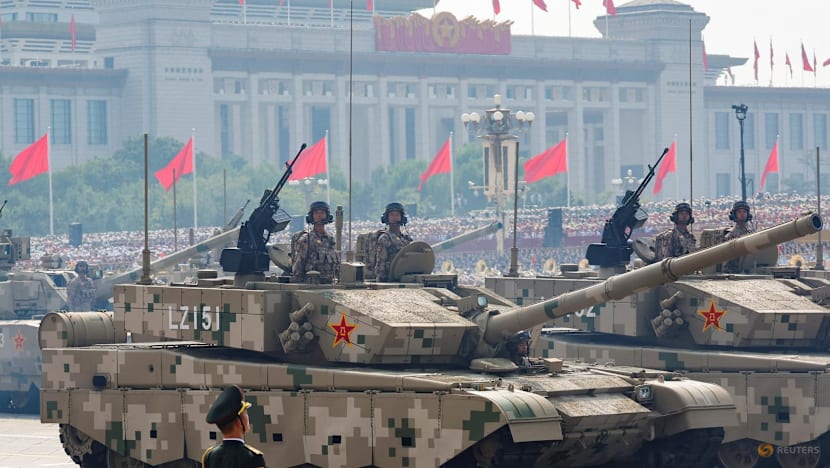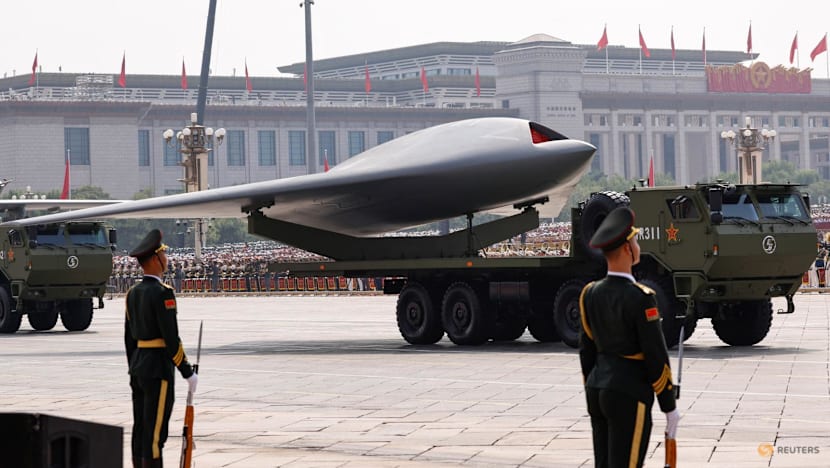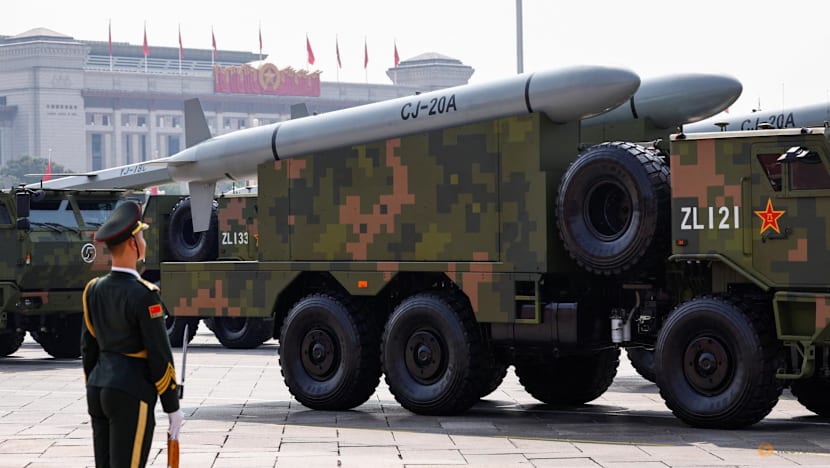Latest China weaponry in parade shows Beijing’s sharp focus on sovereign defence: Analysts

Members of the People's Liberation Army Ground Assault Force drive armoured vehicles during a military parade to mark the 80th anniversary of the end of World War II, in Beijing, China, on Sep 3, 2025. (Photo: Reuters/Maxim Shemetov)

This audio is generated by an AI tool.
Beijing sees Taiwan as part of China to be reunited by force if necessary. Most countries, including the United States, do not recognise Taiwan as an independent state, but Washington is opposed to any attempt to take the self-governed island by force and is committed to supplying it with weapons.
Unlike his speech before the 2019 National Day military parade in which he spoke of “the complete reunification of the nation”, Xi on Wednesday made no mention of Taiwan, as was the case during the 2015 war commemoration.
But many of the displayed weapons held clear implications for Taiwan, analysts said, especially because Beijing earlier described the parade as organised and rehearsed according to combat-readiness standards.
They believe the parade commemorating the 80th anniversary of China’s victory over Japan in World War II showed Beijing’s defence posture of seeking to deter Taiwan as well as its preparedness for possible amphibious operations and US military intervention.
Military analyst Fu Qianshao said the parade illustrated the PLA’s ambitious vision for an integrated system for island landings, including possible operations against Taiwan, featuring coordination between the army, marine corps and airborne troops.
“These three units will work together to carry out three-dimensional warfare,” Fu said.
Wednesday’s parade marked the debut, for example, of a lighter, new-generation tank called the Type 100, the analyst added.
Designed to better survive drone strikes, the model is more suitable for potential operations in Taiwan due to its mobility, after the PLA apparently learned lessons from the failure of conventional tanks on the battlefields of the Ukraine war.
Fu said the medium-weight tank had an advanced active protection system that improved its survivability in the age of drones and made it better for landing operations.
The tank’s lighter weight enables it to operate across a wider range of terrain, including high-altitude regions and beach landings, where soft sand or mud can hinder heavier tanks.

The parade also featured multiple unmanned ground vehicles and aerial drones, as well as anti-drone platforms, which Fu believed could be the first to be used in any future Taiwan operation rather than crewed platforms.
“It’s very likely the first wave (of landing forces) will be unmanned, with platforms like unmanned boats, combat vehicles and even robot dogs leading the initial assault,” Fu said of the scenario.
In addition, the parade saw both the army and navy showcase uncrewed systems for the first time.
The army’s uncrewed systems include reconnaissance-strike and assault vehicles capable of executing “diverse military missions” alongside unmanned vehicles for mine clearance, explosive ordnance disposal and path-clearing operations.

On Wednesday, mainland military expert Wang Yunfei told Global Times, a newspaper affiliated with Communist Party mouthpiece People’s Daily, that such equipment could “provide formidable support” during an amphibious assault.
The newspaper quoted mainland military expert Zhang Yunlei as saying the unmanned submarines, unmanned surface vessels and unmanned minelaying systems on display could “restrict enemy naval activity and sever adversary maritime supply lines”.
Other weapons perceived as targeting Taiwan included the PHL-16 rocket launcher, also known as the PCL-191.
This multiple rocket launcher system is seen as playing a crucial role in potential contingencies across the Taiwan Strait thanks to its long-range strike ability.
It is regarded as the Chinese equivalent of Lockheed Martin’s High Mobility Artillery Rocket System (Himars), which Taipei has procured and deployed.
The PLA is only two years away from its centenary goal. In his 20th party congress report in 2022, Xi said that by 2027 China should be capable of winning “a local war”.

Some American officials, including Admiral John Aquilino, former head of the US Indo-Pacific Command, and former CIA director William Burns, have said the PLA will move to take Taiwan by 2027.
Xi has said China is committed to achieving peaceful reunification through the “one country, two systems” arrangement with “utmost sincerity”.
Song Zhongping, a military commentator and former PLA instructor, said: “Beijing’s primary objective is to achieve victory without resorting to arms by deterring and containing pro-independence elements in Taiwan through this concentrated display of military hardware.”
The parade sent a message of deterrence to foreign powers regarding the Taiwan Strait, with the show of force comprising land-, sea- and air-based nuclear missiles.
State media described the capability as constituting “a strategic ace for safeguarding national sovereignty and defending national dignity”.
Song added that Beijing sought to “deter and shield against interference by external powers in China’s internal affairs through this move, particularly concerning the Taiwan issue and South China Sea matters”.
Certain equipment showcased in the parade would also be used should the US intervene in combat in the Taiwan Strait, a scenario widely anticipated to involve American aircraft carriers, especially if deployed in the western Pacific Ocean.
The latest anti-ship missile systems displayed on Wednesday included the YJ-15, YJ-19 and YJ-20.
Believed to utilise ramjet propulsion, these systems are specifically engineered for high-speed combat missions and designed to deliver rapid strikes against enemy vessels.
The YJ-20, in particular, is considered a “carrier killer” of the next generation, capable of targeting both maritime and land-based objectives simultaneously.
Another crucial weapon in a possible Taiwan conflict would be the DF-26D anti-ship ballistic missile, which is reported to carry both nuclear and conventional warheads and have a range of 5,000km.
It has been called the “Guam killer” for its ability to target US military bases on the American territory and Washington’s naval assets in the western Pacific.
In October, China’s two aircraft carriers, the Liaoning and the Shandong, conducted joint exercises in the western Pacific as part of its strategy to deter the US from taking military action in the region.
Meanwhile, the nation’s third carrier, the Fujian, is expected to enter service this year.
On Wednesday, China showcased its latest carrier-based aircraft, which are tailored for the Fujian’s electromagnetic launch system, including the J-15T and J-15DT.
State media also stressed the importance of the stealth, carrier-based J-35 fighter jet in defending the “far seas”.
This article was first published on SCMP.

















